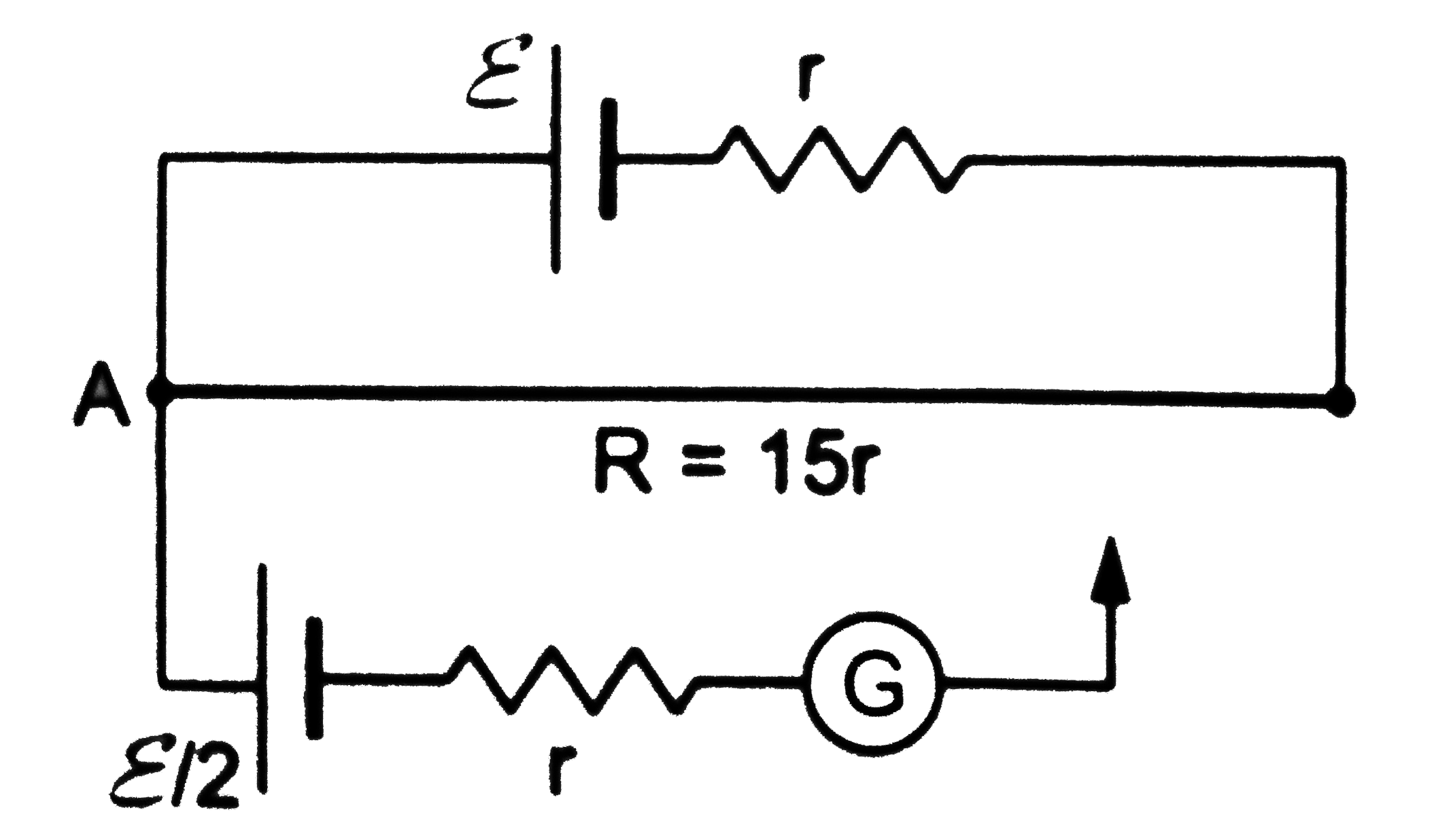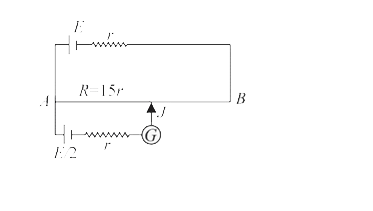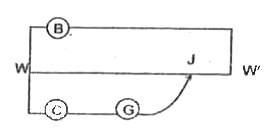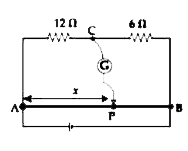Consider the potentiometer circuit arranged as in figure. The potentiometer wire is 600cm long. At what distance from the point A should the jockey touch the wire to get zero deflection in the galvanometer? b) If the jockey touches the wire at a distance of 560cm from A, What will be the current in the galvanometer?
 Solution in Tamil
Solution in Tamil
Resistance per unit length = 15r/6
For length x, rx = 15rx/6
For the loop PASQ
(i1+i1)156rx+156r(6−x)i1+i1r=ε………….(i)
for the loop awtm,
i2r−156rx(i1+i1)=ε2
⇒i2+156rx(i1+i1)=ε2...........(ii)
For zero deflection in galvanometer, i2=0 .
156rx.i1=ε2
⇒i1=ε5.r
Pu∈gi1=ε5.r
andi2=0∈eqn.(i)
we≥t,x=320cm.
(b)Pu∈gx=5.6andsolv∈gequation
(i)&(ii)
we≥t,i2=2ε22r .
Topper's Solved these Questions
- BOOK - HC VERMACHAPTER - ELECTRIC CURRENT IN CONDUCTORSEXERCISE - objective 29videos
ELECTRIC CURRENT IN CONDUCTORS
- BOOK - HC VERMACHAPTER - DISPERSION AND SPECTRAEXERCISE - Exercises11videos
DISPERSION AND SPECTRA
- BOOK - HC VERMACHAPTER - ELECTRIC CURRENT THROUGH GASESEXERCISE - Exercise23videos
ELECTRIC CURRENT THROUGH GASES
Similar Questions
Electrons are emitted by a hot filament and are accelerated by an electric field as shown in figure .The two stops at the left ensure that the electron beam has a uniform cross-section.
 03:36View Solution
03:36View SolutionA flint glass prism and a crown glass prism are to be combined in such a way that the deviation of the mean ray is zero. The refractive index of flint and crown glasses for the mean ray are 1.620 and 1.518 respectively. If the refracting angle of the flint prism is 6.0∘, what would be the refracting angle of the crown prism ?
01:23View SolutionA discharge tube contains helium at a low pressure. A large potential difference is applied across the tube. Consider a helium atom that has just been ionized due to the detachment of an atomic electron. Find the ratio of the distance travelled by the free electron to that by the positive ion in a short time dt after the ionization.
05:37View SolutionThe potentiometer wire AB is 600 cm long. a. At what distance from A should be jockey J touch the wire to get zero deflection i the galvanometer. b. If the jockey touches the wire at a distance 560 cm from A, what will be the current through the galvanometer.
02:53View SolutionIt is advised that the jockey is not to be rubbed on potentiometer wire while using it?
03:22View SolutionA potentiometer wire AB as shown in 40 cm long of resistance 50Omega//m free end of an ideal galvanometer is touching the potentiometer wire with the help of a jockey. What should be the velocity of the jockey as a function of time so that potential difference across the galvanometer is varying with time as (2sinpit)V
View SolutionWhat is the potential difference between the ends A and B of the given potentiometer wire, in the following circuit ? The galvanometer G shows no deflection.
View SolutionThe potentiometer wire AB is 600cm long. At what distance (in cm) from A should the jockey J touch the wire to get zero deflection in the galvanometer?
 01:53View Solution
01:53View SolutionWhy should the jockey be not rubbed against potentiometer wire ?
View SolutionIn the adjoining figure of a potentiometer arrangement, B is the main battery, C is the cell whose emf is to be determined, WW' is the potentiometer wire, G is the galvanometer and Jis the jockey which may touch any point on the wire WW'. Choose the correct alternativels for the potentiometer to work properly
 02:59View Solution
02:59View SolutionWhy jockey should not be slided along the potentiometer wire?
05:29View SolutionWhy should the jockey be not rubbed against the potentiometer wire ?
02:02View SolutionConsider a 72 cm long wire AB as shown in the figure. The galvonometer jockey is placed at P on AB at a distance x cm from A. The galvanometer shows zero deflectinN.

The value of x, to the nearest integer, is ...........04:58View SolutionThe potentiometer wire AB is 600 cm long. a. At what distance from A should be jockey J touch the wire to get zero deflection i the galvanometer. b. If the jockey touches the wire at a distance 560 cm from A, what will be the current through the galvanometer.
02:37View SolutionIn the circuit, given figure below the length of the wire AB = 400 cm. Where should the jockey J be placed, so that the galvanometer shows a zero deflection?
03:42View SolutionA potentiometer wire AB as shown in 40 cm long of resistance 50Omega//m free end of an ideal galvanometer is touching the potentiometer wire with the help of a jockey. What should be the velocity of the jockey as a function of time so that potential difference across the galvanometer is varying with time as (2sinpit)V
05:17View Solution

